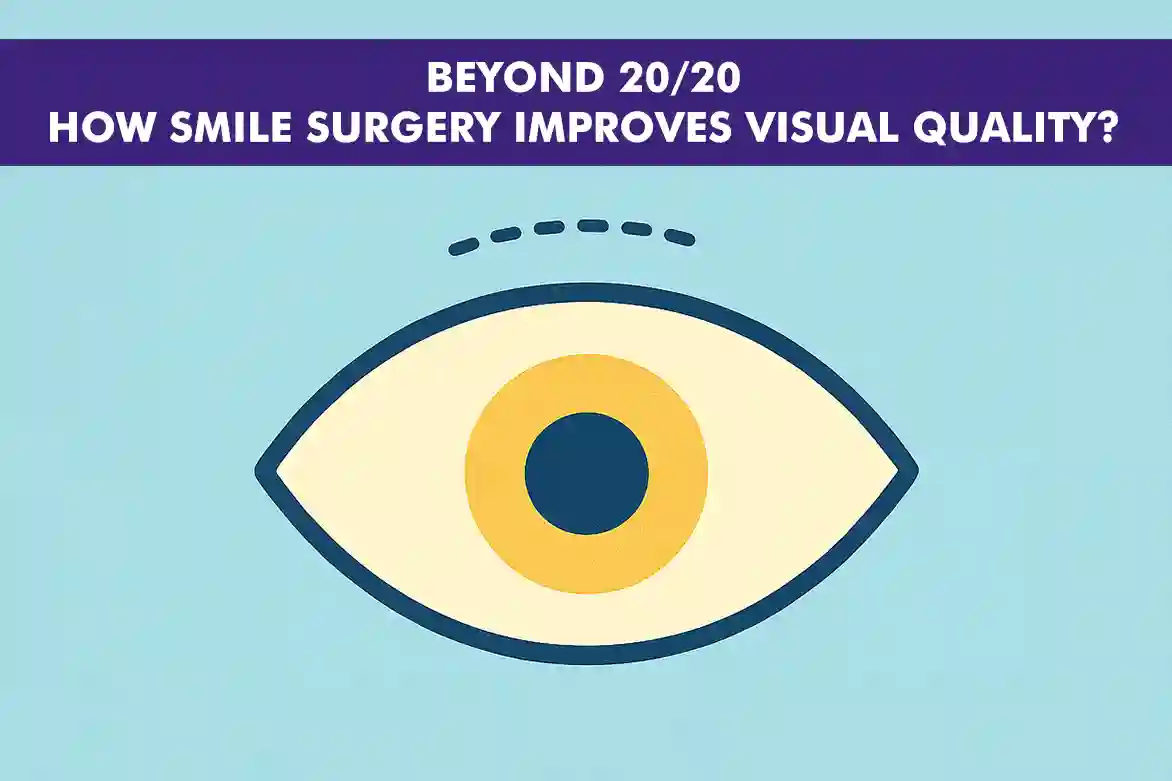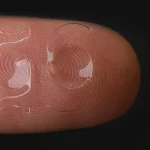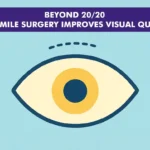In the ever-evolving field of vision correction, where technological advancements continually push the boundaries of what’s possible, Small Incision Lenticule Extraction (SMILE) surgery emerges as a revolutionary procedure. This cutting-edge technique is not just another option; it represents a paradigm shift in how we approach vision correction, offering a blend of precision, safety, and comfort that is unparalleled. Designed to enhance visual quality and maximize patient comfort, SMILE is rapidly gaining recognition and making significant waves in the healthcare industry. This blog will delve into the intricacies of SMILE surgery, exploring how it works, its benefits, real-life success stories, and whether it could be the right choice for you.
What Is SMILE Surgery & How Does It Work?
Unlike flap-based surgery like LASIK or traditional PRK eye surgery, SMILE surgery is a minimally invasive refractive procedure designed to correct myopia (nearsightedness) and astigmatism. The process begins with the patient lying comfortably on a surgical bed, where the eye is numbed using anesthetic eye drops to ensure a painless experience.
Step 1: The surgeon uses a femtosecond laser, a highly precise laser, to create a small lenticule, which is a thin, disc-shaped piece of tissue, within the cornea. This laser operates with incredible accuracy, ensuring that the lenticule is formed at the correct depth and size necessary for the desired vision correction.
Step 2: Once the lenticule is created, the surgeon makes a tiny incision, typically less than 3 millimeters, on the surface of the cornea. This incision is significantly smaller than the flap created in traditional LASIK surgery, contributing to the minimally invasive nature of the procedure.
Step 3: Through this small incision, the surgeon carefully extracts the lenticule. The removal of this tissue causes the cornea to change shape, which is the key to correcting the refractive error. By reshaping the cornea, the light entering the eye can be properly focused onto the retina, thereby improving vision.
Step 4: After the lenticule is removed, the incision naturally heals without the need for stitches. The small size of the incision promotes faster healing and reduces the risk of complications, such as infections or flap-related issues that can occur with LASIK surgery.
This step-by-step approach of SMILE surgery not only enhances visual acuity but also offers a quicker recovery time and fewer complications compared to traditional methods, making it an appealing option for many patients seeking vision correction.
The Benefits of SMILE Surgery Over Traditional LASIK
- Minimally Invasive Procedure: SMILE surgery does not involve creating a corneal flap, which eliminates the risk of flap-related complications. This is particularly beneficial for individuals involved in contact sports or physical jobs, as there is no flap to dislodge or heal. In contrast, LASIK surgery requires a corneal flap, which can be a concern for those with active lifestyles.
- Reduced Postoperative Dry Eye: Patients undergoing SMILE surgery often experience less dry eyes after the procedure. This is because the surgery preserves more of the corneal nerves, which are crucial for tear production. LASIK, on the other hand, can disrupt these nerves more significantly, leading to a higher incidence of dry eye symptoms.
- Faster Recovery Time: SMILE allows for a quicker overall recovery, enabling patients to resume their daily activities sooner. This is due to the smaller incision and less invasive nature of the procedure. LASIK, while also offering relatively quick recovery, involves a larger incision and flap creation, which can extend the healing process.
The Science Behind Improved Visual Quality with SMILE
The precision of the femtosecond laser employed in SMILE surgery is pivotal in achieving highly accurate reshaping of the cornea, which is essential for optimal visual outcomes. This precision minimizes the likelihood of side effects such as halos and glare, which are common concerns in vision correction procedures. By ensuring that the corneal adjustments are exact, SMILE enhances the clarity and sharpness of vision, providing patients with a more natural visual experience.
Additionally, SMILE’s approach significantly reduces the risk of inducing higher-order aberrations, which are complex distortions that can affect visual quality. Unlike traditional LASIK, which may inadvertently introduce these aberrations, SMILE’s method maintains the integrity of the corneal structure, leading to superior visual quality. This is particularly beneficial for activities requiring high visual acuity, such as night driving or sports, where clear and precise vision is crucial.
Furthermore, the reduced incidence of postoperative complications contributes to a more comfortable recovery and long-term satisfaction with the visual results. Overall, SMILE’s innovative technique offers a comprehensive enhancement of visual quality from multiple perspectives, making it a preferred choice for many seeking vision correction.
Are There Any Limitations to SMILE Surgery?
While SMILE surgery provides a range of benefits, it is important to understand that it may not be the best option for everyone seeking vision correction.
- SMILE surgery is designed to correct myopia (nearsightedness) and astigmatism (irregular curvature of the eye).
- It is not as effective for treating hyperopia (farsightedness), where distant objects are clearer than near ones.
- Individuals with certain corneal conditions, like keratoconus or thin corneas, may not be suitable candidates.
- Those who have had previous refractive surgeries might not achieve the desired results due to altered corneal structure.
- A thorough evaluation by an eye care professional is crucial to determine if SMILE is appropriate for specific vision needs and eye health.
Is SMILE Surgery Right for You? Key Considerations
- Evaluate your vision requirements.
- Consider your lifestyle and how it may impact recovery.
- Assess your overall eye health.
- Consult with an eye care professional.
- Check corneal thickness and prescription stability.
- Determine if SMILE surgery is the most suitable option for you.
When contemplating SMILE surgery, it is crucial to evaluate your vision requirements and consider how your lifestyle may influence the recovery process.
Conclusion
SMILE surgery represents a significant advancement in vision correction, offering numerous benefits over traditional methods like LASIK surgery. With its minimally invasive approach, quicker recovery times, and improved visual outcomes, SMILE is becoming an increasingly popular choice for many patients.
If you are considering vision correction surgery, consult with a qualified eye care professional to explore whether SMILE is the right fit for your needs.
FAQs
While SMILE surgery significantly improves visual quality, it does not guarantee 20/20 vision for all patients. However, most patients achieve excellent vision without the need for glasses or contact lenses.
SMILE surgery can also improve night vision by reducing higher-order aberrations that cause issues like halos and glare.
In terms of safety, SMILE is considered to be at least as safe as LASIK, if not safer, due to its minimally invasive nature.
Patients can typically expect to see improvements in visual quality within a few days after the procedure, with full benefits realized within a few weeks.
As with any surgical procedure, there is a slight risk of visual quality decreasing over time, but this is rare and often manageable with follow-up care.





